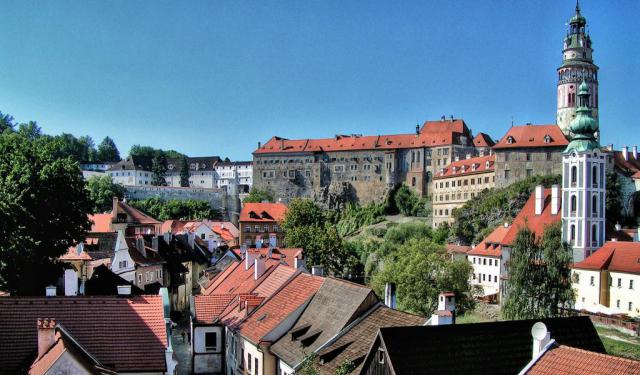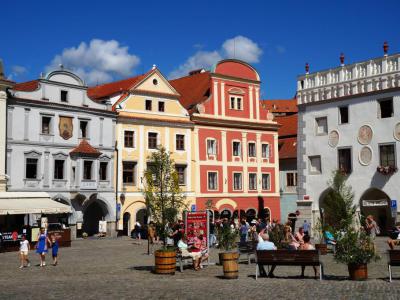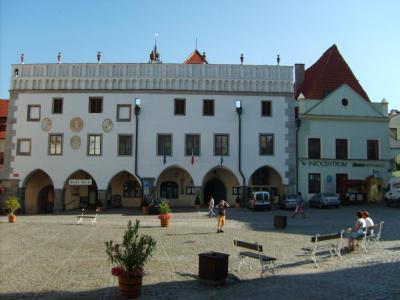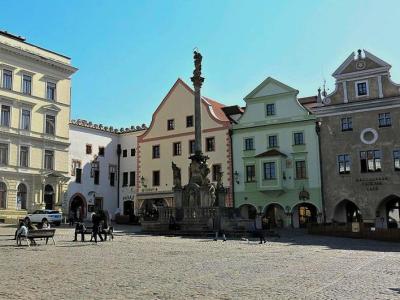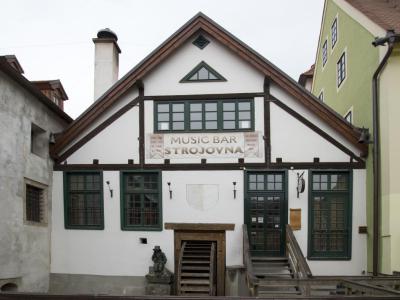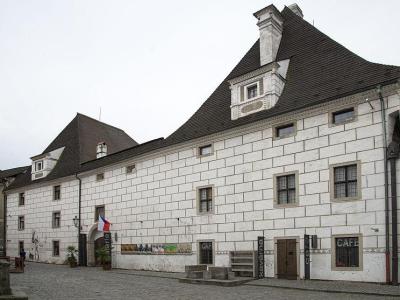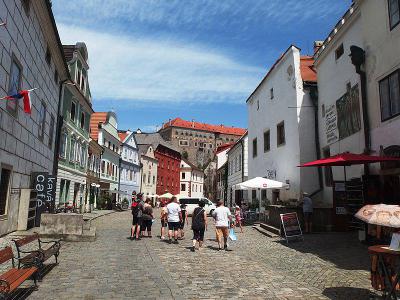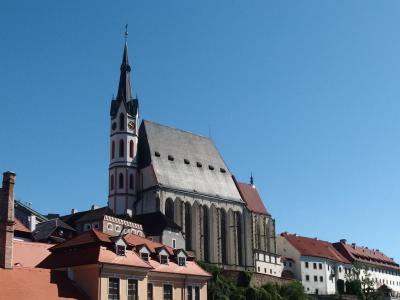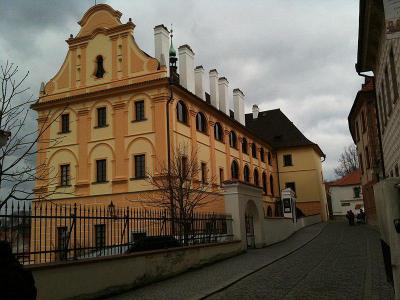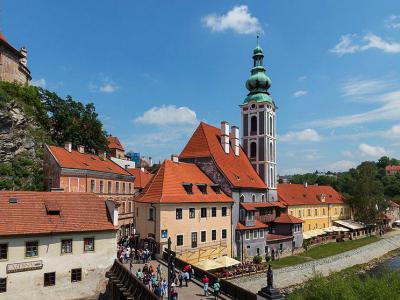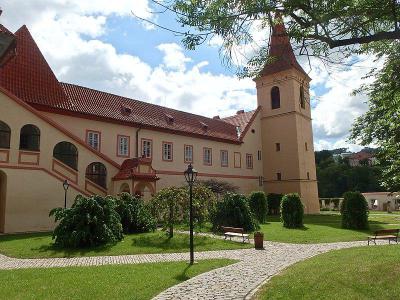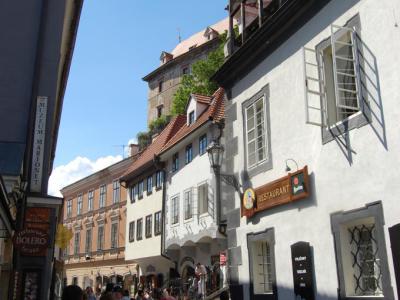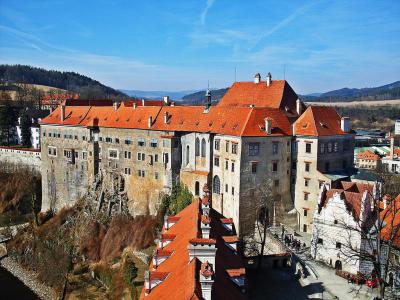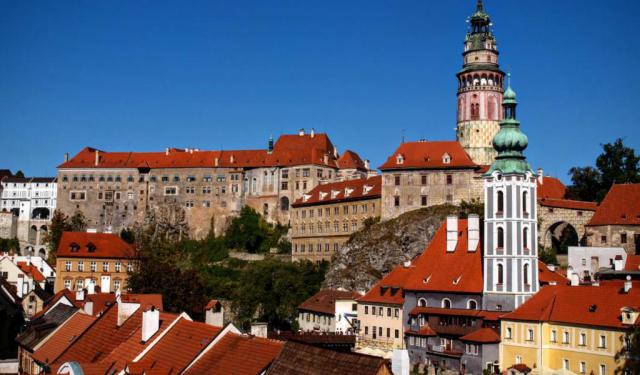Cesky Krumlov Introduction Walking Tour (Self Guided), Cesky Krumlov
Cesky Krumlov is the second most popular tourist destination in the Czech Republic, trailing only Prague, the capital, in terms of visitors. And it’s no wonder since this medieval, UNESCO-listed town is simply the prettiest.
The name Cesky Krumlov has an intriguing etymology, in which "Cesky" means "Czech," while "Krumlov" is derived from the German name "Krumme Aue," translating to "crooked meadow." This moniker captures the town's geographical setting along the winding curves of the Vltava River.
The town traces its history back to the 13th century. It was developed in two stages, with the first part, Latran, emerging beneath the Cesky Krumlov Castle in the 1250s and what's now known as the Old Town area established later.
The town flourished under the prominent Bohemian noble family of Rosenberg, expanding its territory and promoting trade and crafts. The discovery of gold in the late 15th century attracted German miners and further diversified the population. William of Rosenberg united Latran and Old Town in 1555 and renovated the castle in the Renaissance style during the late 16th century.
After changing hands several times, the town became part of Czechoslovakia in 1919, following World War I. Annexed by Nazi Germany in 1938, it was later returned to Czechoslovakia post-World War II. Cesky Krumlov faced neglect during the Communist era but experienced a revival after the Velvet Revolution in 1989, becoming a renowned tourist destination, with many historic sites restored to their former glory.
One of the central hubs of Cesky Krumlov is Unity Square (Namesti Svornosti). The Town Hall (Radnice) dominates this square with its Gothic and Renaissance elements. Nearby, the Plague Column serves as a poignant reminder of the town's struggles with epidemics in the past.
Wandering along the cobblestone streets, you'll encounter the Krumlov Mill, which once played a vital role in the town's economy, and the former Municipal Brewery, now serving as an art center.
Religious architecture also holds a significant place in Cesky Krumlov. The Church of Saint Vitus (Kostel Svateho Vita) showcases exquisite Gothic Revival elements.
The Latran Houses are another architectural marvel, displaying a fusion of Gothic and Renaissance styles.
Cesky Krumlov makes a popular day trip from Prague, but it’s worth staying here overnight and enjoying all the best things without too many people around. As you stroll through the town's narrow alleys, soak in its historical ambiance and admire its architectural gems. Cesky Krumlov's heritage will undoubtedly weave its magic upon you.
The name Cesky Krumlov has an intriguing etymology, in which "Cesky" means "Czech," while "Krumlov" is derived from the German name "Krumme Aue," translating to "crooked meadow." This moniker captures the town's geographical setting along the winding curves of the Vltava River.
The town traces its history back to the 13th century. It was developed in two stages, with the first part, Latran, emerging beneath the Cesky Krumlov Castle in the 1250s and what's now known as the Old Town area established later.
The town flourished under the prominent Bohemian noble family of Rosenberg, expanding its territory and promoting trade and crafts. The discovery of gold in the late 15th century attracted German miners and further diversified the population. William of Rosenberg united Latran and Old Town in 1555 and renovated the castle in the Renaissance style during the late 16th century.
After changing hands several times, the town became part of Czechoslovakia in 1919, following World War I. Annexed by Nazi Germany in 1938, it was later returned to Czechoslovakia post-World War II. Cesky Krumlov faced neglect during the Communist era but experienced a revival after the Velvet Revolution in 1989, becoming a renowned tourist destination, with many historic sites restored to their former glory.
One of the central hubs of Cesky Krumlov is Unity Square (Namesti Svornosti). The Town Hall (Radnice) dominates this square with its Gothic and Renaissance elements. Nearby, the Plague Column serves as a poignant reminder of the town's struggles with epidemics in the past.
Wandering along the cobblestone streets, you'll encounter the Krumlov Mill, which once played a vital role in the town's economy, and the former Municipal Brewery, now serving as an art center.
Religious architecture also holds a significant place in Cesky Krumlov. The Church of Saint Vitus (Kostel Svateho Vita) showcases exquisite Gothic Revival elements.
The Latran Houses are another architectural marvel, displaying a fusion of Gothic and Renaissance styles.
Cesky Krumlov makes a popular day trip from Prague, but it’s worth staying here overnight and enjoying all the best things without too many people around. As you stroll through the town's narrow alleys, soak in its historical ambiance and admire its architectural gems. Cesky Krumlov's heritage will undoubtedly weave its magic upon you.
How it works: Download the app "GPSmyCity: Walks in 1K+ Cities" from Apple App Store or Google Play Store to your mobile phone or tablet. The app turns your mobile device into a personal tour guide and its built-in GPS navigation functions guide you from one tour stop to next. The app works offline, so no data plan is needed when traveling abroad.
Cesky Krumlov Introduction Walking Tour Map
Guide Name: Cesky Krumlov Introduction Walking Tour
Guide Location: Czech Republic » Cesky Krumlov (See other walking tours in Cesky Krumlov)
Guide Type: Self-guided Walking Tour (Sightseeing)
# of Attractions: 12
Tour Duration: 2 Hour(s)
Travel Distance: 1.6 Km or 1 Miles
Author: DanaOffice
Sight(s) Featured in This Guide:
Guide Location: Czech Republic » Cesky Krumlov (See other walking tours in Cesky Krumlov)
Guide Type: Self-guided Walking Tour (Sightseeing)
# of Attractions: 12
Tour Duration: 2 Hour(s)
Travel Distance: 1.6 Km or 1 Miles
Author: DanaOffice
Sight(s) Featured in This Guide:
- Namesti Svornosti (Unity Square)
- Radnice (Town Hall)
- Plague Column
- Krumlov Mill
- Mestsky Pivovar (Municipal Brewery)
- Siroka Ulice (Wide Street)
- Kostel Svateho Vita (Church of Saint Vitus)
- Regionalni Muzeum (Regional Museum)
- Kostel Svateho Josta (Church of St. Joseph)
- Minoritsky Klaster (Minorite Monastery)
- Latran Houses
- Zamek Cesky Krumlov (Cesky Krumlov Castle)
1) Namesti Svornosti (Unity Square)
The Unity Square has been a central hub in Cesky Krumlov since the medieval foundation of the town. The square is lined with a mix of Renaissance and Baroque buildings that were constructed on 12th-century Gothic foundations. Several buildings on the square stand out for their valuable stucco and painted decorations. Notable examples include the hotel at No. 13 and the house at No. 14.
Dominating the square is the Marian Plague Column, erected in 1716. At its pinnacle, you'll find a statue of the Virgin Mary Immaculate, surrounded by eight saints who are the city's patrons and believed to offer protection against the plague.
The 16th-century town hall stands as one of the square's focal points. The town hall houses the Torture Museum in its basement. This museum provides visitors with a unique opportunity to explore the darker aspects of history while surrounded by the town's architectural splendor.
In 1843, a stone fountain was introduced alongside the plague column, replacing the earlier Renaissance fountain that previously graced the square. This fountain enhances the square's visual appeal.
The square is surrounded by charming buildings that house restaurants, small shops, and cafés. It's an excellent place to enjoy a meal, indulge in some shopping, or simply soak in the atmosphere.
Dominating the square is the Marian Plague Column, erected in 1716. At its pinnacle, you'll find a statue of the Virgin Mary Immaculate, surrounded by eight saints who are the city's patrons and believed to offer protection against the plague.
The 16th-century town hall stands as one of the square's focal points. The town hall houses the Torture Museum in its basement. This museum provides visitors with a unique opportunity to explore the darker aspects of history while surrounded by the town's architectural splendor.
In 1843, a stone fountain was introduced alongside the plague column, replacing the earlier Renaissance fountain that previously graced the square. This fountain enhances the square's visual appeal.
The square is surrounded by charming buildings that house restaurants, small shops, and cafés. It's an excellent place to enjoy a meal, indulge in some shopping, or simply soak in the atmosphere.
2) Radnice (Town Hall)
The Town Hall has served as the town hall since 1597, making it a hub for civic activities and governance. Today, it continues to house the town office and features the Museum of Torture, offering insights into the darker aspects of history.
The building is the result of combining several original Gothic houses, making it a unique and asymmetrical structure. Its facade, facing south towards the square, received a Renaissance-style attic in the 16th century, contributing to its distinctive appearance. It showcases six pointed arches of a portico supported by chamfered prismatic pillars, reflecting late Gothic architectural influences. The portico's ceiling is elegantly vaulted with a cross vault.
Adorning the left half of the facade are four stucco signs. These include the coat of arms of Český Krumlov, the coat of arms of the Czech Republic, the coat of arms of the Eggenberg family to the left, and the coat of arms of the Schwarzenberg family to the right. The building features an attic with two bands of semi-pillars and cones, crowned by Rococo vases made of fired clay. The attic covers three gabled roofs that run perpendicular to the facade. A small bell can be seen in the upper left corner, just below the attic.
Access to the interior is through a broken Gothic portal, adding to the building's charm. The entrance hall is vaulted with a ridge and barrel vault, preserving fragments of two Gothic portals featuring the motif of intersecting rods. Upstairs, there is a hall with a modern beamed ceiling on stilts.
The Town Hall has historically been entrusted with safeguarding important city valuables, including three golden keys to the city gates and the city seal. It also held ownership of a plan of Krumlov and several busts commemorating significant local figures.
The building is the result of combining several original Gothic houses, making it a unique and asymmetrical structure. Its facade, facing south towards the square, received a Renaissance-style attic in the 16th century, contributing to its distinctive appearance. It showcases six pointed arches of a portico supported by chamfered prismatic pillars, reflecting late Gothic architectural influences. The portico's ceiling is elegantly vaulted with a cross vault.
Adorning the left half of the facade are four stucco signs. These include the coat of arms of Český Krumlov, the coat of arms of the Czech Republic, the coat of arms of the Eggenberg family to the left, and the coat of arms of the Schwarzenberg family to the right. The building features an attic with two bands of semi-pillars and cones, crowned by Rococo vases made of fired clay. The attic covers three gabled roofs that run perpendicular to the facade. A small bell can be seen in the upper left corner, just below the attic.
Access to the interior is through a broken Gothic portal, adding to the building's charm. The entrance hall is vaulted with a ridge and barrel vault, preserving fragments of two Gothic portals featuring the motif of intersecting rods. Upstairs, there is a hall with a modern beamed ceiling on stilts.
The Town Hall has historically been entrusted with safeguarding important city valuables, including three golden keys to the city gates and the city seal. It also held ownership of a plan of Krumlov and several busts commemorating significant local figures.
3) Plague Column
The centerpiece of Union Square is the Plague Column. At the pinnacle of the column stands a majestic statue of the Virgin Mary, serving as a symbol of hope and protection. Surrounding her are eight statues of saints, each revered as patrons of the town and revered as protectors against the devastating plague.
In the upper row of statues, you'll find the figures of Saint Wenceslas, Saint Vitus, Saint John the Evangelist, and Saint Judas Thaddeus, forming a powerful spiritual presence overlooking the square. Below them, the lower row features Saint Francis Xavier, Saint Sebastian, Saint Gaetano, and Saint Rochus, further emphasizing the town's unwavering faith in divine intervention during times of plague and adversity.
The exceptional Baroque sculptural decoration adorning the Plague Column is credited to the talented Prague sculptor Matěj Václav Jäckel, who worked tirelessly on this masterpiece between 1714 and 1716.
In 1843, a notable addition was made to the Plague Column with the construction of a stone fountain reservoir. This feature was introduced to replace the earlier Renaissance-style fountain that once graced the center of Union Square. While serving practical purposes, the stone fountain also adds to the square's aesthetic appeal.
In the upper row of statues, you'll find the figures of Saint Wenceslas, Saint Vitus, Saint John the Evangelist, and Saint Judas Thaddeus, forming a powerful spiritual presence overlooking the square. Below them, the lower row features Saint Francis Xavier, Saint Sebastian, Saint Gaetano, and Saint Rochus, further emphasizing the town's unwavering faith in divine intervention during times of plague and adversity.
The exceptional Baroque sculptural decoration adorning the Plague Column is credited to the talented Prague sculptor Matěj Václav Jäckel, who worked tirelessly on this masterpiece between 1714 and 1716.
In 1843, a notable addition was made to the Plague Column with the construction of a stone fountain reservoir. This feature was introduced to replace the earlier Renaissance-style fountain that once graced the center of Union Square. While serving practical purposes, the stone fountain also adds to the square's aesthetic appeal.
4) Krumlov Mill
The Krumlov Mill's historical record traces back to 1347 when it was first documented in the writings of Petr Vok of Rožmberk, a noble family closely associated with the town. From its early days, this mill played a significant role in the local economy and community.
In 1596, a pivotal moment occurred when Petr Vok of Rožmberk decided to relinquish his servile wages in favor of the town, effectively transferring ownership of the mill to the municipality. This transition marked the mill's shift from noble control to communal ownership. The mill saw further changes in ownership dynamics, with Antonín Postel becoming the first emphyteutic owner in 1782. Emphyteutic ownership implies a shared property arrangement involving authorities and a landlord.
During the early 17th century, between 1608 and 1611, major renovations were undertaken to enhance the mill's infrastructure and functionality. These efforts likely improved its milling capabilities and ensured its continued importance to the town.
When you have the chance to visit the Krumlov Mill, be sure to inquire about the enchanting legend of the "Pearl Oyster Boy." This delightful tale adds to the mill's unique charm. Nowadays, the mill offers a diverse array of attractions, creating a captivating blend of experiences for visitors to enjoy.
In 1596, a pivotal moment occurred when Petr Vok of Rožmberk decided to relinquish his servile wages in favor of the town, effectively transferring ownership of the mill to the municipality. This transition marked the mill's shift from noble control to communal ownership. The mill saw further changes in ownership dynamics, with Antonín Postel becoming the first emphyteutic owner in 1782. Emphyteutic ownership implies a shared property arrangement involving authorities and a landlord.
During the early 17th century, between 1608 and 1611, major renovations were undertaken to enhance the mill's infrastructure and functionality. These efforts likely improved its milling capabilities and ensured its continued importance to the town.
When you have the chance to visit the Krumlov Mill, be sure to inquire about the enchanting legend of the "Pearl Oyster Boy." This delightful tale adds to the mill's unique charm. Nowadays, the mill offers a diverse array of attractions, creating a captivating blend of experiences for visitors to enjoy.
5) Mestsky Pivovar (Municipal Brewery)
The Municipal Brewery, which is now the Egon Schiele Art Centrum, is a historic Renaissance building that was once home to a brewery established by the municipality. Located on Siroka Street this complex consists of two houses.
The second building, Siroka no. 71, was created through a Renaissance reconstruction of medieval houses between 1578 and 1605. The design was attributed to the Italian architect Domenico Benedetto Cometa from Eckthurm, with construction overseen by Hans Haas. Later, in 1875-1876, the building at Siroka no. 70 was attached after undergoing its own reconstruction and served as a refrigerator. Additional structures were added on Hradebni Street in the 1870s, leading to a complex of interconnected buildings.
The brewery commenced operations in 1605 and continued brewing until 1949 when it ceased production. After the brewery's closure, the site was repurposed as a warehouse. In 1993, the Egon Schiele Art Center was established within these historic walls. The center features a permanent exhibition dedicated to the life and work of the artist Egon Schiele and has gained international recognition as a highly visited cultural institution in Cesky Krumlov.
The second building, Siroka no. 71, was created through a Renaissance reconstruction of medieval houses between 1578 and 1605. The design was attributed to the Italian architect Domenico Benedetto Cometa from Eckthurm, with construction overseen by Hans Haas. Later, in 1875-1876, the building at Siroka no. 70 was attached after undergoing its own reconstruction and served as a refrigerator. Additional structures were added on Hradebni Street in the 1870s, leading to a complex of interconnected buildings.
The brewery commenced operations in 1605 and continued brewing until 1949 when it ceased production. After the brewery's closure, the site was repurposed as a warehouse. In 1993, the Egon Schiele Art Center was established within these historic walls. The center features a permanent exhibition dedicated to the life and work of the artist Egon Schiele and has gained international recognition as a highly visited cultural institution in Cesky Krumlov.
6) Siroka Ulice (Wide Street)
The Wide Street is, indeed, the widest street in Cesky Krumlov. This street holds historical significance as it used to be the central location for medieval markets. During the Middle Ages, towns like Cesky Krumlov were granted licenses by the Emperor to organize markets, and this street served as the primary market square.
Cesky Krumlov was permitted to hold four annual markets, one weekly market, and various horse and cattle markets throughout the year. These markets were significant events for the small town, attracting over three hundred merchants. Weekly markets featured local merchants selling eggs, corn, poultry, butter, vegetables, and other essential goods, making Široká Ulice the economic hub of medieval Cesky Krumlov.
Today, Wide Street is home to several famous buildings, including the Alchemist's House and Jakub Kercin's House, which serve as reminders of the town's rich historical past and its role as a bustling market center during medieval times.
Cesky Krumlov was permitted to hold four annual markets, one weekly market, and various horse and cattle markets throughout the year. These markets were significant events for the small town, attracting over three hundred merchants. Weekly markets featured local merchants selling eggs, corn, poultry, butter, vegetables, and other essential goods, making Široká Ulice the economic hub of medieval Cesky Krumlov.
Today, Wide Street is home to several famous buildings, including the Alchemist's House and Jakub Kercin's House, which serve as reminders of the town's rich historical past and its role as a bustling market center during medieval times.
7) Kostel Svateho Vita (Church of Saint Vitus) (must see)
The Church of Saint Vitus plays a vital role in shaping the city's skyline alongside the castle tower, which represents secular authority. These two landmarks coexist harmoniously and reflect the unique artistic character of Cesky Krumlov.
Built between 1407 and 1439, the Church of Saint Vitus has undergone various modifications over the centuries. It was constructed on the foundations of an earlier church dating back to 1309. The Gothic entrance portal, which graces the church's facade, was added in 1410. During the 17th and 18th centuries, the church underwent expansion and alterations to its original structure.
The church itself features a three-nave hall with an elongated, pentagonally shaped presbytery. On either side of the presbytery, you'll find rectangular sacristies and chapels dedicated to the Resurrection and Saint Jan Nepomucký. There is also an antechamber with an entrance portal on the north side of the church. The west facade of the church boasts a tower adorned with prismatic Romanesque windows on the ground floor and octagonal windows on the upper levels. The tower's topmost floor, added in 1893-1894, exhibits pseudo-Gothic elements, serving as a later addition to the structure.
In recognition of its historical and architectural significance, the Church of Saint Vitus was designated a National Cultural Monument in 1995. It stands as a testament to the city's rich heritage and the enduring influence of ecclesiastical power in the region.
Built between 1407 and 1439, the Church of Saint Vitus has undergone various modifications over the centuries. It was constructed on the foundations of an earlier church dating back to 1309. The Gothic entrance portal, which graces the church's facade, was added in 1410. During the 17th and 18th centuries, the church underwent expansion and alterations to its original structure.
The church itself features a three-nave hall with an elongated, pentagonally shaped presbytery. On either side of the presbytery, you'll find rectangular sacristies and chapels dedicated to the Resurrection and Saint Jan Nepomucký. There is also an antechamber with an entrance portal on the north side of the church. The west facade of the church boasts a tower adorned with prismatic Romanesque windows on the ground floor and octagonal windows on the upper levels. The tower's topmost floor, added in 1893-1894, exhibits pseudo-Gothic elements, serving as a later addition to the structure.
In recognition of its historical and architectural significance, the Church of Saint Vitus was designated a National Cultural Monument in 1995. It stands as a testament to the city's rich heritage and the enduring influence of ecclesiastical power in the region.
8) Regionalni Muzeum (Regional Museum)
The Regional Museum is housed in a historic building that dates back to 1650-1652. Originally, this building served as a Jesuit seminary, a center for the Jesuit order's educational activities. However, in 1773, the Jesuit order was abolished, and subsequently, the seminary was discontinued as well by a decree issued in 1777. The building then underwent various educational uses, first as the main German school (Haupschule) and later as a German municipal gymnasium, remaining so until 1945.
The current appearance of the building is the result of a reconstruction effort that took place from 1970 to 1980. After this reconstruction, the Regional Museum established its workplace and exhibition rooms within the premises.
Today, the Regional Museum in Cesky Krumlov is home to several remarkable exhibits. Among its treasures are a detailed ceramic model portraying the historical core of Český Krumlov, depicting the city's idealized form around the year 1800. Additionally, visitors can explore the preserved interior of a Baroque Jesuit pharmacy dating back to the mid-17th century. The museum offers a wide range of collections and permanent exhibitions covering archaeology, the history of arts and crafts, ethnography, and historical pharmacy. Moreover, the museum hosts various temporary exhibitions throughout the year, making it a dynamic and engaging cultural destination for visitors interested in exploring the history and heritage of Cesky Krumlov and its surrounding region.
The current appearance of the building is the result of a reconstruction effort that took place from 1970 to 1980. After this reconstruction, the Regional Museum established its workplace and exhibition rooms within the premises.
Today, the Regional Museum in Cesky Krumlov is home to several remarkable exhibits. Among its treasures are a detailed ceramic model portraying the historical core of Český Krumlov, depicting the city's idealized form around the year 1800. Additionally, visitors can explore the preserved interior of a Baroque Jesuit pharmacy dating back to the mid-17th century. The museum offers a wide range of collections and permanent exhibitions covering archaeology, the history of arts and crafts, ethnography, and historical pharmacy. Moreover, the museum hosts various temporary exhibitions throughout the year, making it a dynamic and engaging cultural destination for visitors interested in exploring the history and heritage of Cesky Krumlov and its surrounding region.
9) Kostel Svateho Josta (Church of St. Joseph)
The Church of Saint Joseph origins date to before 1334 when the chapel of Saint Joseph was established by Peter I of Rožmberk, as part of the Rožmberk manor hospital. In 1596, Petr Vok initiated a Renaissance reconstruction of the church, and by 1598, it was consecrated for Protestant use. However, in 1600, Emperor Rudolf II prohibited its non-Catholic use.
With the Josephine reforms of 1787, the church was abolished and closed. Its destiny took on various roles over the years. During the early 18th century, it served as a casino with a bar and a dance hall on the upper floors. After 1900, the building was primarily used as a residential structure, with ground-floor shops and a restaurant. In the early 1920s, it housed the Baťa company store, among other businesses.
Today, the church has been transformed into the Rafting Museum. This museum provides insights into the history and traditions of rafting in the Czech Republic. Visitors can explore the exhibition, featuring the second-largest model of a raft spring in the country and information about raft construction. Additionally, there is an opportunity to visit the tower, providing panoramic views of Cesky Krumlov and the surrounding area.
With the Josephine reforms of 1787, the church was abolished and closed. Its destiny took on various roles over the years. During the early 18th century, it served as a casino with a bar and a dance hall on the upper floors. After 1900, the building was primarily used as a residential structure, with ground-floor shops and a restaurant. In the early 1920s, it housed the Baťa company store, among other businesses.
Today, the church has been transformed into the Rafting Museum. This museum provides insights into the history and traditions of rafting in the Czech Republic. Visitors can explore the exhibition, featuring the second-largest model of a raft spring in the country and information about raft construction. Additionally, there is an opportunity to visit the tower, providing panoramic views of Cesky Krumlov and the surrounding area.
10) Minoritsky Klaster (Minorite Monastery)
The Minorite Monastery is a hidden gem tucked away from the bustling tourist routes behind the townhouses within the Lateran castle grounds. It stands as the second-largest historical complex in Český Krumlov, following the castle area.
The Twin Convent of Brothers and Sisters of the Order of Saint Frantiska was established in 1350 by Kateřina from Rožmberk and her four sons. The first Minorites arrived in 1357, followed by the Poor Clares in 1361. Over the centuries, these monasteries evolved into significant centers of religious life, culture, education, and pilgrimage.
During the Josephine reforms in 1782, the convent of the Poor Clares was disbanded, and in 1950, exactly 600 years after its foundation, the Minorite monastery met the same fate.
At the heart of the connected Minorite and Poor Clares monasteries lies the Church of the Corpus Christi and the Blessed Virgin Mary. This Twin Monastery, in its current form, stands as one of the most architecturally preserved monastic complexes in the Czech Republic.
Today, the Monastery welcomes visitors year-round and offers intriguing tours. Now owned by the Knights of the Cross with the Red Star, it provides a captivating glimpse into the Chapel of Saint Wolfgang. Here, rare Gothic frescoes were uncovered beneath layers of mold, fungus, and plaster. These frescoes have been meticulously restored, complementing the existing baroque fragments on the chapel's walls and the baroque ceiling depicting the life of Saint Wolfgang. Within the monastery, you can also admire statues such as the Black Madonna in the Chapel of Our Lady of Einsiedelnská, the Krumlov Madonna, and the Třeboň Madonna.
The Twin Convent of Brothers and Sisters of the Order of Saint Frantiska was established in 1350 by Kateřina from Rožmberk and her four sons. The first Minorites arrived in 1357, followed by the Poor Clares in 1361. Over the centuries, these monasteries evolved into significant centers of religious life, culture, education, and pilgrimage.
During the Josephine reforms in 1782, the convent of the Poor Clares was disbanded, and in 1950, exactly 600 years after its foundation, the Minorite monastery met the same fate.
At the heart of the connected Minorite and Poor Clares monasteries lies the Church of the Corpus Christi and the Blessed Virgin Mary. This Twin Monastery, in its current form, stands as one of the most architecturally preserved monastic complexes in the Czech Republic.
Today, the Monastery welcomes visitors year-round and offers intriguing tours. Now owned by the Knights of the Cross with the Red Star, it provides a captivating glimpse into the Chapel of Saint Wolfgang. Here, rare Gothic frescoes were uncovered beneath layers of mold, fungus, and plaster. These frescoes have been meticulously restored, complementing the existing baroque fragments on the chapel's walls and the baroque ceiling depicting the life of Saint Wolfgang. Within the monastery, you can also admire statues such as the Black Madonna in the Chapel of Our Lady of Einsiedelnská, the Krumlov Madonna, and the Třeboň Madonna.
11) Latran Houses
The historical core of Cesky Krumlov consists of two distinct parts, with Latran being one of them. Latran, whose name is derived from the Latin word "latus," meaning "side" or "lateral," originally developed spontaneously beneath the castle on the left bank of the Vltava River. In the past, Latran was not even part of the town's administration but later became incorporated in 1555 by Vilem of Rozmberk. This district primarily housed individuals whose work contributed to the smooth functioning of the castle and the surrounding area.
Latran is home to a collection of late Gothic and Renaissance houses, each with its unique and intriguing architectural features. House No. 53 and House No. 39 are noteworthy for their intricate decor. House No. 39, in particular, boasts a wall mural depicting the Rožmberk rider. Houses No. 37 and No. 15 are architecturally significant, featuring valuable Gothic interior paintings that provide a glimpse into the artistic heritage of the region. House No. 54, located near the Red Gate, belonged to Josef Rosenauer (1735-1804), the Schwarzenberg builder and engineer responsible for constructing the famous Schwarzenberg Navigational Canal in 1782.
The Latran houses collectively represent a remarkable architectural heritage that deserves careful exploration and appreciation. Each house along this picturesque street is a masterpiece in its own right, akin to an exhibit in a living museum.
Latran is home to a collection of late Gothic and Renaissance houses, each with its unique and intriguing architectural features. House No. 53 and House No. 39 are noteworthy for their intricate decor. House No. 39, in particular, boasts a wall mural depicting the Rožmberk rider. Houses No. 37 and No. 15 are architecturally significant, featuring valuable Gothic interior paintings that provide a glimpse into the artistic heritage of the region. House No. 54, located near the Red Gate, belonged to Josef Rosenauer (1735-1804), the Schwarzenberg builder and engineer responsible for constructing the famous Schwarzenberg Navigational Canal in 1782.
The Latran houses collectively represent a remarkable architectural heritage that deserves careful exploration and appreciation. Each house along this picturesque street is a masterpiece in its own right, akin to an exhibit in a living museum.
12) Zamek Cesky Krumlov (Cesky Krumlov Castle) (must see)
The history of Český Krumlov Castle dates back to the 13th century when it was built by the powerful Vítkovci family. Over the centuries, it changed hands several times, with each owner contributing to its architectural and cultural heritage.
The castle is a harmonious blend of various architectural styles, including Gothic, Renaissance, and Baroque. The castle complex consists of a series of courtyards, palaces, and gardens, each with its unique charm. Notable areas include the Upper Castle, the Lower Castle, and the impressive Castle Theatre.
The Castle Tower, which rises high above the town, offers panoramic views of Český Krumlov and the Vltava River. Climbing the tower is a popular activity for visitors seeking stunning vistas. The castle houses several museums, including the Baroque Pharmacy Museum, displaying an extensive collection of historical pharmacy artifacts.
The castle is surrounded by splendid gardens, including the Baroque Castle Garden and the English Park. These gardens offer a peaceful retreat with manicured lawns, fountains, and scenic viewpoints.
The castle is a harmonious blend of various architectural styles, including Gothic, Renaissance, and Baroque. The castle complex consists of a series of courtyards, palaces, and gardens, each with its unique charm. Notable areas include the Upper Castle, the Lower Castle, and the impressive Castle Theatre.
The Castle Tower, which rises high above the town, offers panoramic views of Český Krumlov and the Vltava River. Climbing the tower is a popular activity for visitors seeking stunning vistas. The castle houses several museums, including the Baroque Pharmacy Museum, displaying an extensive collection of historical pharmacy artifacts.
The castle is surrounded by splendid gardens, including the Baroque Castle Garden and the English Park. These gardens offer a peaceful retreat with manicured lawns, fountains, and scenic viewpoints.
Walking Tours in Cesky Krumlov, Czech Republic
Create Your Own Walk in Cesky Krumlov
Creating your own self-guided walk in Cesky Krumlov is easy and fun. Choose the city attractions that you want to see and a walk route map will be created just for you. You can even set your hotel as the start point of the walk.
Cesky Krumlov Castle Grounds Walk
Perhaps the main draw of Cesky Krumlov is its imposing castle, looming over the Old Town. Being one of Central Europe's most extensive castle complexes, it boasts a total of 40 buildings and five castle courtyards, making it an undeniably impressive sight. The origins of this castle trace back to approximately 1240, but its current Baroque appearance hails from the late 17th and early 18th... view more
Tour Duration: 1 Hour(s)
Travel Distance: 0.9 Km or 0.6 Miles
Tour Duration: 1 Hour(s)
Travel Distance: 0.9 Km or 0.6 Miles
The Most Popular Cities
/ view all
